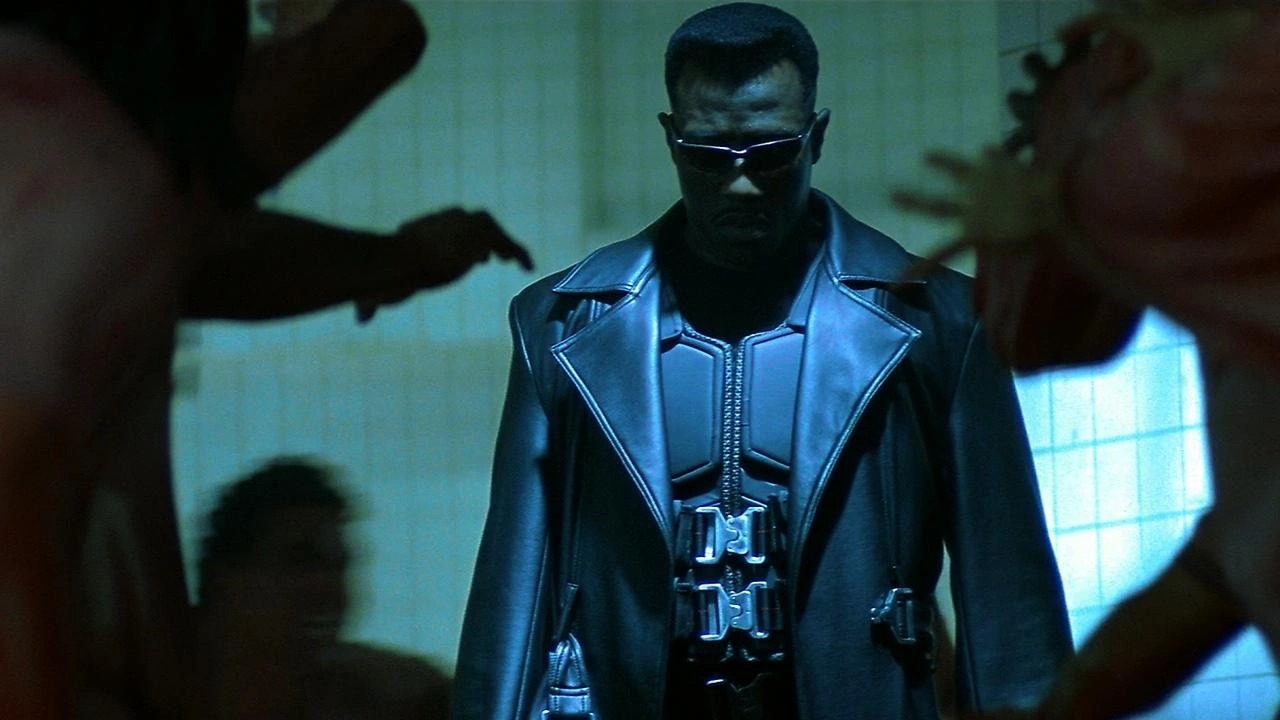Blade (1998)

“Blade” (1998) is a landmark film in the superhero genre, directed by Stephen Norrington and written by David S. Goyer. Based on the Marvel Comics character of the same name, “Blade” marks the beginning of a successful film series that would shape the future of superhero cinema. The film features Wesley Snipes in the titular role, alongside a supporting cast that includes Stephen Dorff, Kris Kristofferson, and N’Bushe Wright. With its dark tone, stylish action sequences, and innovative approach to the vampire genre, “Blade” played a crucial role in popularizing superhero films in the late 1990s and early 2000s.
The film introduces us to Blade (Wesley Snipes), a half-vampire, half-human hybrid who possesses all the strengths of vampires but none of their weaknesses, except for a thirst for blood. Blade has dedicated his life to eradicating vampires from the world. His unique nature allows him to walk in the shadows while battling the supernatural creatures that threaten humanity. The film’s plot centers around Blade’s quest to thwart the plans of Deacon Frost (Stephen Dorff), a powerful vampire who seeks to unleash an ancient vampire deity known as La Magra and bring about a new era of vampire domination.

Wesley Snipes delivers a charismatic and commanding performance as Blade. His portrayal captures the character’s inner conflict, strength, and resolve, presenting a superhero who is both a fierce warrior and a deeply troubled individual. Blade’s struggle with his own vampiric nature and his quest for vengeance against the creatures that have wronged him adds emotional depth to the character, making him more than just a typical action hero.
Stephen Dorff’s portrayal of Deacon Frost is equally notable. As the primary antagonist, Frost is a charismatic yet ruthless vampire who represents a significant threat to Blade. Dorff’s performance brings a blend of arrogance and menace to the role, making Frost a memorable villain whose ambitions drive much of the film’s conflict. His character’s desire to overthrow the traditional vampire hierarchy and usher in a new era of vampiric dominance provides the central narrative thrust of the film.
Stephen Norrington’s direction of “Blade” is characterized by its dark and stylish aesthetic. The film’s visual style, marked by its use of shadowy, neon-lit environments and kinetic action sequences, reflects the gritty, urban setting of the story. Norrington’s approach to the film’s action scenes, including its martial arts choreography and special effects, sets a high standard for superhero and action films that followed.
The cinematography by Matthew F. Leonetti plays a significant role in establishing the film’s moody atmosphere. The use of lighting, camera angles, and color palettes enhances the film’s dark and intense tone, contributing to its overall impact. The visual style is both sleek and gritty, fitting the film’s narrative and thematic elements.
“Blade” features a mix of practical effects and CGI, which were innovative for its time. The film’s action sequences are fast-paced and expertly choreographed, showcasing Blade’s martial arts skills and his combat with various supernatural foes. The practical effects, including makeup and prosthetics, effectively bring the vampires and their transformations to life, while the CGI is used to enhance the supernatural elements of the story.
The film’s notable action scenes include Blade’s battle against a group of vampires at a blood rave, where the film’s unique take on vampire lore is vividly portrayed. The choreography and execution of these sequences demonstrate the film’s commitment to delivering high-energy action and spectacle.
“Blade” explores themes of identity, vengeance, and the struggle between good and evil. Blade’s dual nature as both human and vampire adds complexity to his character, as he navigates his role as a hero while grappling with his own inner demons. The film also delves into themes of power and control, particularly through the character of Deacon Frost and his desire to overturn the existing vampire order.
The film’s impact on the superhero genre is significant. “Blade” is often credited with paving the way for a new era of superhero films, especially those with darker, more mature themes. Its success demonstrated that superhero movies could be both commercially viable and critically acclaimed, leading to a resurgence in the genre that included films such as “X-Men” (2000) and “Spider-Man” (2002). The film’s success also led to the creation of two sequels, “Blade II” (2002) and “Blade: Trinity” (2004), further cementing its place in cinematic history.

The film’s soundtrack, featuring a mix of hip-hop, electronic, and industrial music, complements its urban and edgy aesthetic. The music, produced by composers such as Mark Isham and featuring tracks by artists like The Prodigy and Moby, enhances the film’s atmosphere and contributes to its energetic and dynamic feel. The soundtrack plays a key role in setting the tone and immersing viewers in the film’s world.

In conclusion, “Blade” (1998) is a groundbreaking film that combines action, horror, and superhero elements to create a unique and influential entry in the genre. Directed by Stephen Norrington and written by David S. Goyer, the film features a compelling performance by Wesley Snipes as the titular character, alongside a memorable villain portrayed by Stephen Dorff. With its stylish direction, innovative special effects, and impactful soundtrack, “Blade” set a new standard for superhero films and paved the way for future entries in the genre. Its legacy endures as a testament to its significance in shaping modern superhero cinema and its role in establishing darker, more complex narratives within the genre.










